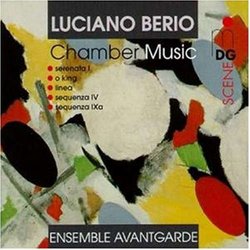| All Artists: Luciano Berio, Ensemble Avantgarde, Steffen Schleiermacher, Josef Christof, Kerstin Klein Title: Berio: Chamber Music Members Wishing: 0 Total Copies: 0 Label: MD&G Records Release Date: 6/16/1998 Genres: Pop, Classical Styles: Vocal Pop, Opera & Classical Vocal, Ballets & Dances, Ballets, Chamber Music, Forms & Genres, Concertos, Short Forms, Historical Periods, Classical (c.1770-1830), Modern, 20th, & 21st Century, Instruments, Keyboard, Reeds & Winds Number of Discs: 1 SwapaCD Credits: 1 UPC: 760623075426 |
Search - Luciano Berio, Ensemble Avantgarde, Steffen Schleiermacher :: Berio: Chamber Music
 | Luciano Berio, Ensemble Avantgarde, Steffen Schleiermacher Berio: Chamber Music Genres: Pop, Classical
|
Larger Image |
CD Details |
CD ReviewsComplex assortment Mark Grindell | Shipley,West Yorkshire | 07/11/1999 (5 out of 5 stars) "The first remark on this collection is that the pieces here are remarkably difficult, even for very experienced players in this genre.The two solo sequenzas extend the resources of the players in remarkable ways.Sequenza IV is apparently a favorite piece now at piano competitions; one of the hardest aspects of its performance is its very difficult time structure. The piece seems to contain two basic types of structure - dense polyphonic chords, or very fast, nervous lines of melody which contain variable elements wrapped around the same centre. The effect is to express ideas which are dramatic and very complex. The beginning two chords (which can be interpreted as a conventional dominant to tonic progression of two generators), is the beginning of an idea which reappears at the end with the final set of chords, transformed, and subdued. There is a great deal of excitement and fury inbetween, one short section containing fast, hammer like tone clusters - here the piano is truly played as a percussion instrument - and the very interestng thing is how this short, intense section resolves very quickly and successfuly into something with a local tonal texture - quite a surprise, and worth hearing the piece for.Sequenza IXa for saxaphone is demanding if for nothing but its quite considerable length as a solo piece. It contains narrative elements which are very reminiscent of jazz, and possibly has one of the strongest unambiguous tonal feel of all the sequenzas.Serenata I is an early work which is in some ways connected to the kind of world inhabited by the first sequenza, in which the dominant feel and texture is somewhat freer than strict serial technique, probably somewhere in the journey from Allelujah II to the kind of writing that characterised the later pieces such as Differences. It has a very strong set of themes which develop in an appealing way.O King might be familiar as the second movement of Symphonia, and is dedicated to Martin Luther King. That name is repeated softly under a blanket of sounds, soft and disquieting, with the intonation of voices and brass mingling and interchanging. A inquiet elegy.Linea is a remarkably difficult piece to play, requiring considerable expertise not only for each player, but as a group. Scored for two pianos, marimba, and vibraphone, it consists of thirteen movements which are played more or less without a break - Manege I, Entree I, Ensemble I, Manege II, Ensemble II, Manege III, Ensemble III, Entree II, Coda I, Allegro. Coda II, Ensemble IV, Notturno.Each is characterised by a separate treatment of a developing theme which starts from a very simple idea - a minor third (C sharp to E) repeated softly by all members of the ensemble, then slowly developed into more complex melodic material.The beginnning theme often reappears, but sometimes in an unfamiliar rhythmic context, and often incorporated into larger structures, sets of chromatic arpeggios which stride over several octaves.The difficult nature of the work lies in the very close homophonic style of writing, varying from a moderate speed to sometimes very fast, making demands on sychronisation and accuracy considerable. The music alternates between a single line of melody and a more polyphonic sound, but I suspect that the title "Linea" comes from the intent to describe a process, a long thread, where the origin and destination are singular and mysterious.The final movement is very captivating, and has a soft, ambiguous ending (a tremolando chord with C, F, E, A flat, C Sharp, G, F Sharp, E flat, D, B, and A). But by this time this sound has been in the listeners ear for some time, either as melodic material, or a harmonic fragments, and there is a definite sense of arriving in the new country."
|

 Track Listings (5) - Disc #1
Track Listings (5) - Disc #1